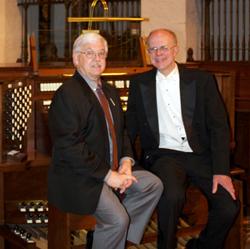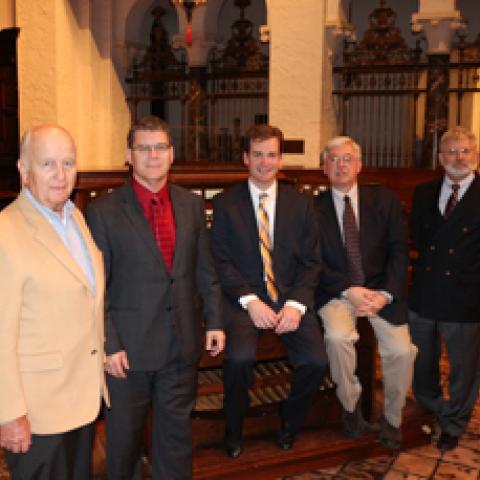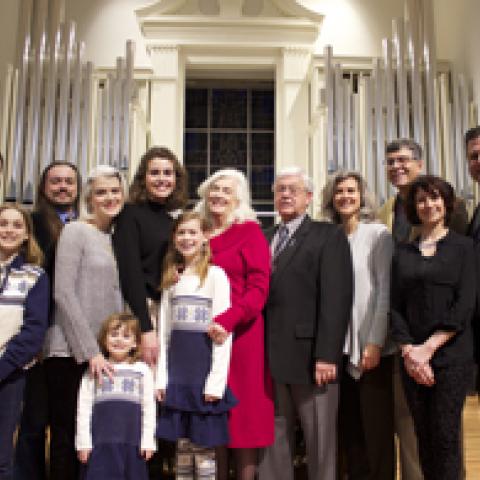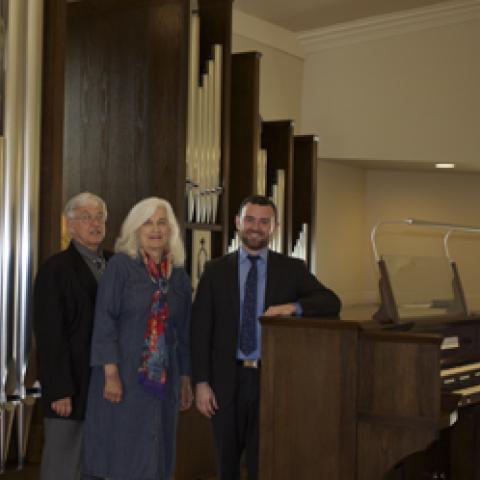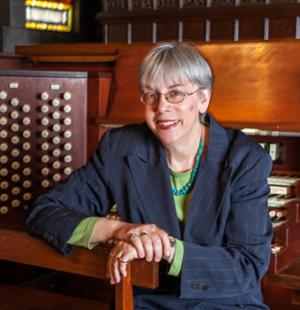The University of Michigan 52nd Conference on Organ Music took place September 30–October 3. The annual conference is organized by Marilyn Mason, who has brought world-class performers and scholars to Ann Arbor for some 51 years. The conference offered a feast of sounds, from the 16th-century organ Mass Missa Kyrie fons bonitatis, to the world premiere of Three Pieces for Organ by Czech composer Jirí Teml; performers ranged in age from “twenty-somethings” to seasoned veterans. This year’s conference inaugurated a new event—an improvisation competition. The five contestants dazzled the audience with their ingenuity, creativity, and ability to transform a simple melody into new music. As Michael Barone commented, “The organ is a magnificent creation, but it only comes alive when people play it.”
Sunday, September 30
4 pm, Hill Auditorium
The opening event, Kipp Cortez’s master’s degree recital, signaled the excellence and vitality that were to mark the entire conference. His formidable technique was apparent in his program: Carillon by Leo Sowerby; Prelude, adagio et choral varié sur le thème du ‘Veni Creator’, op. 4, by Maurice Duruflé (the performance was enhanced by the singing of the Gregorian hymn by St. Andrew’s Episcopal Church compline ensemble, directed by Deborah Friauff); Les Corps Glorieux (Le mystère de la Sainte Trinité, VII) by Olivier Messiaen; Rhapsody in D-flat Major, op. 17, no. 1, by Herbert Howells; and Variations sur un vieux Noël by Marcel Dupré. The latter was a tour de force. The crowd stood and cheered his playing.
8 pm, Hill Auditorium
Almut Roessler, the renowned interpreter of Messiaen’s organ works, was scheduled to perform; however, due to circumstances beyond her control, she had to cancel her U.S. tour only two weeks before the conference. David Wagner was chosen to play the concert in her place. He was a great choice: a native Michigander, born and raised in Detroit, a sought-after recitalist, a well-known radio personality, and professor of music and university organist at Madonna University in Livonia, Michigan. He is the program director and music host of the classical music station WRCJ-FM in Detroit. He opened and closed his recital with William Mathias’s Processional (1964) and Recessional—pieces that exploited the instrument’s broad and rich spectrum of colors. Dr. Dave “the artist” and Dr. Dave “the raconteur” delighted the crowd with four centuries of organ music and commentary, explaining the connection between these disparate works: Versets on Veni Creator Spiritus by Nicolas de Grigny; Passacaglia and Fugue in C Minor, BWV 582, by J. S. Bach; and Sonata No. 1, op. 42, by Alexandre Guilmant. These composers are linked together by fortuitous events. Wagner pointed out that while no autograph copies from de Grigny exist, we have J. S. Bach’s hand-copied manuscript of de Grigny. He also related that in 1908 Guilmant directed the first publication of de Grigny’s organ works and that Guilmant played the basis of his Symphony No. 1 on the organ built by the Farrand & Votey Company in 1893 for the World’s Columbian Exposition in Chicago, which was purchased by the University of Michigan in 1894 and has since been named the Frieze Memorial Organ. It was rebuilt and reconditioned by the Aeolian-Skinner Organ Company of Boston and resides in Hill Auditorium.
Tuesday, October 2
Michael Barone, host of Pipedreams, presented a fascinating pastiche of recordings culled from his vast library in his lecture, “Imagining the Future, Celebrating the Past.” He presented organ music by contemporary composers who are stretching the boundaries of old forms, combining other instruments with the organ, and implementing Danish and Norwegian folk songs, jazz, and blues in new ways. Barone played numerous examples of intriguing new music for the organ that finds inspiration in J. S. Bach and old hymn tunes.
The first composer on his list of “cutting edge” composers was Henry Martin, who teaches composition at Rutgers University; he received the 1991 National Composers Competition and the Barlow International Composition Competition in 1998 for his Preludes and Fugues for Piano. Barone commissioned him to compose organ preludes and fugues in G major and E minor for the 25th anniversary concert of Pipedreams that took place at the 2008 AGO convention in Minneapolis; Ken Cowan premiered the works. Since then Barone has commissioned preludes and fugues in D major and B minor, which Cowan premiered in 2009; Prelude and Fugue in E Major, premiered by Isabelle Demers in 2012; and Stephen Tharp has agreed to premiere the next set of preludes and fugues.
Henry Martin’s “new music” interjects jazz, burly elements of dissonance, kaleidoscopic colors, and shifting textures into the constructs of the preludes and fugues of Bach’s Well Tempered Clavier. In his Prelude and Fugue in G Major the virtuosic demands are apparent in the perpetual motion of the prelude and the driving intensity of the fugue.
To illustrate the pulsing life of organ music today, Barone played many recordings of live improvisations as well as new music. This list includes only a few of the recordings presented: Gunnar Idenstam, Folkjule: A Swedish Folk Song Christmas and Songs for Jukksjarvi: Swedish Folk Songs; Matt Curlee/Neos Ensemble of jazz-styled arrangements for organ, violin, vibraphone, and drums; Barbara Dennerlein playing jazz on the pipe organ; and Monte Mason, Psalm 139 for choir, organ and electronics.
Barone continued by pointing out that Paul Winter in his Winter Solstice concerts at the Cathedral of St. John the Divine uses the organ as the bedrock of his composition, and that Cameron Carpenter, playing in the Royal Albert Hall in London at end of the Olympics, stretched the boundaries of organ composition and made us feel as uncomfortable as Bach’s contemporaries were with him. Barone admonished us to find new audiences for the organ, to go beyond all the wonderful pieces we know, and explore the huge amount of repertoire that’s not played and can be adapted “if you push the right crescendo pedal.”
One of the most enlightening and entertaining events of the conference was Steven Ball’s lecture/recital, “Introduction to the Theater Organ,” given at the Michigan Theater, which proudly houses a 1927 Barton theater organ, the oldest unaltered organ in Ann Arbor. Steven Ball wears several hats—organist at the Michigan Theater, University of Michigan carillonneur, and manager of the Stearns Collection of Musical Instruments, as well as director of music at the Catholic Cathedral of the Most Blessed Sacrament in Detroit.
Ball began his presentation with a quiz. We were given the specifications of four pipe organs and asked to identify the country of origin, location, builder, date, and whether it was a theater organ. The last question was difficult: how can you tell from the specifications if the organ is a theater organ? The answer is, you can’t! Dr. Ball’s lecture was fueled by the criteria applied to the selection of each of the 2,500 instruments in the Stearns Collection: i.e., each piece was chosen to show how instruments evolve, aid in the study of organology, and promote the understanding of world cultures and music.
Ball explained what happens when a musical instrument evolves, and pointed out there is a cultural relevance and progression accompanying this evolution. (1) There is a dialogue between builders and composers. When the Barker Lever was introduced in 1837 to the organ at St. Denis, an envelope was being pushed, facilitating the composition of new organ music. (2) Change is marked by acoustical evolution: sound gets louder and the compass expands. He noted that the theater organ was specifically voiced and designed to duplicate the sounds of an orchestra, and using analog technology first produced what we know as “surround sound.” (3) As instruments evolve, they become more vocal in nature—organ students are constantly told to let the music “breathe.”
Steven Ball offered a brief history of the theater organ, commenting that Robert Hope-Jones created more patents for the theater organ than anyone. He invented the Tibia Clausa, stoptabs instead of drawknobs, increased the wind pressures (ranging from 10 to 50 inches), and enclosed the pipes behind walls and thick swell shades for greater expression. The merger of his company with Wurlitzer in 1914 ended in disappointment and led to his suicide in 1915. In 1927 Wurlitzer cranked out an organ a day for a demanding market, and organists were paid for playing in the theater.
The Michigan Theater organ, opus 245, was built in 1927 by the Barton Company, which employed 150 people, taught students to play, and placed them in theaters throughout the Midwest. The instrument is only one of 40 that exists in its original home with its original operating system intact, which includes combination action and console lift.
Steven Ball also proved to be the consummate entertainer. For 30 minutes we watched “One Week,” a silent film starring Buster Keaton, while he improvised on the Barton organ. What fun to watch and hear the misadventures of Buster Keaton in high style.
Improvisation competition
For the first time in the conference’s long history, an improvisation competition was included. One could feel the excitement as the audience filed into the sanctuary of St. Francis of Assisi Church for the final round. The sacred space, with its live acoustic and three-manual, 1994 Létourneau Opus 38, provided a perfect venue for the competition. The five finalists were chosen from a preliminary round based on submitted recordings. Judges of the preliminary round included Joanne Vollendorf Clark, Gale Kramer, and Darlene Kuperus. The judges for the final round were Karel Paukert, William Jean Randall, and Pamela Ruiter-Feenstra.
The five finalists were given 30 minutes without an instrument to plan their improvisation, which was to combine a prelude, a toccata, or a fantasia with a fugue on the tune Picardy, and also include a free improvisation on a given theme. Their complete performance time was to last no more that 15 minutes.
It was intriguing to listen to each competitor’s treatment of the themes, to hear music composed before us with marvelous fluidity and agility. We heard borrowings from the medieval ages to the present. No one envied the judges.
Bálint Karosi was awarded the Earl Moore first prize of $3,000; Timothy Tikker was awarded the Palmer Christian second prize of $2,000; Naki Sung Kripfgans the Robert G. Glasgow third prize of $1,000; and Steven Hoffman and Matthew Samelak the runner-up prizes of $500.
The behind-the-scenes organizer, Michele Johns, and her committee of Gale Kramer, Darlene Kuperus, and Marcia Van Oyen did a superb job in planning this remarkable event.
8 pm, Hill Auditorium
It was a privilege to hear Karel Paukert perform Czech organ music as well as pieces that embody the spirit of improvisation. His program gave ample evidence that the repertoire for organ is crossing new boundaries, using colors and timbres in new ways. His playing of Frammenti by Karel Husa (b. 1921), Toccata and Fugue in F Minor by Bedrich Antonín Wiedermann (1884–1951), and Adagio and Postludium from Glagolitic Mass by Leos Janácek (1854–1951) was infused with rare sensitivity and energy. He played cutting edge music by Jirí Teml (b. 1963) and Greg D’Alessio (b. 1963) with the same intensity. We were honored to hear Paukert play the world premiere of Jirí Teml’s Three Pieces for Organ.
Paukert’s choice of “Albion II” from Albion by Greg D’Alessio was a shining example of what can emerge in organ repertoire when tapping into the resources made available in the digital age. Paukert played a score for organ and electronic tape with sounds, he explained, “derived from the electronically processed tonal palette of the McMyler Organ by Holtkamp at the Cleveland Museum of Art.” This piece for organ and electronic accompaniment is definitely New Age music; spellbinding magic resulted by combining digitally manipulated with acoustic sounds of the pipe organ. He concluded his concert with two well-known works, both of which are improvisatory in character and spirit: Jehan Alain’s Deuxième Fantaisie and Franz Liszt’s Prelude and Fugue on the Name of B.A.C.H.
Wednesday, October 3
9:30 am, Blanche Anderson Moore Hall
The 16th-century organ Mass, Missa Kyrie fons bonitatis, was performed by students of Professor James Kibbie: Andrew Earhart and Colin Knapp, with chants sung by Joseph Balistreri. The score will be published by Wayne Leupold in 2013 and is the culmination of ten years of research by Scott Hyslop.
The performance was followed by Scott Hyslop’s lecture, “Pierre Attaingnant: The Royal Printer and the Organ Masses of 1531.” Hyslop’s interest in classical French music was the basis for his doctoral thesis. His continued work on the topic is about to see its fruition in his publication of the performance edition of Attaingnant’s Missa Kyrie fons bonitatis. Hyslop explained that it was a unique accomplishment for Attaingnant to be able to print three items (staff lines, notes, and text) simultaneously and that in 1537 Attaingnant became the official printer and book seller to King Francis I of France. Unlike the popular Missa Cunctipotens, the Missa Kyrie fons bonitatis contains the Credo, which agrees with Paris usage. The new edition will include an accessible essay on musica ficta written by Kimberly Marshall.
2 pm, Hill Auditorium,
lower lobby
Renate McLaughlin, a graduate student of Marilyn Mason, lectured on “Karg-Elert: a musician at the wrong place and the wrong time.” She documented events in the life of the composer that had a negative influence in keeping him from enjoying the recognition he deserved during his lifetime. She presented interesting biographical details that showed him to be out of touch with reality and a man lacking in common sense. Her question of why his dreams of fame and glory were never realized was answered in her lecture topic.
3 pm, Hill Auditorium
The students of James Kibbie played Symphonie No. 6 in G Minor, op. 42, no. 2, by Charles-Marie Widor. His students gave polished performances. The performers and the movements they played were: Colin Knapp (Allegro), Matthew Kim (Adagio), Matthew Dempsey (Intermezzo), Stephanie Yu (Cantabile), and Andrew Lang (Finale).
8 pm, Hill Auditorium
Timothy Tikker, a doctoral candidate studying with Professor Marilyn Mason, programmed an interesting mix of well-known and lesser-known repertoire. Well-known pieces included Mendelssohn’s Sonata in B-flat Major, op. 65, no. 4; J. S. Bach’s Partite diverse sopra il Corale Sei gegrüsset, Jesu gütig, BWV 768; Max Reger’s Toccata and Fugue in d/D, op. 59, nos. 5 and 6; and Messiaen’s Dieu Parmi Nous from La Nativité du Seigneur. It was in the lesser-known pieces that Tikker communicated what seemed to be the essence and soul of the music. He captured the intensity and drama of Ross Lee Finney’s The Leaves on the Trees Spoke. Tikker set the stage of Vincent Persichetti’s Do Not Go Gentle for organ pedals alone, op. 132, by playing a recording of Dylan Thomas reading his poem. Likewise, he seemed to revel in the lyricism and quiet loveliness of Herbert Howells’ Quasi lento, tranquillo from Sonata for Organ.
Conclusion
We thank Marilyn Mason and all who participated in the 52nd Conference on Organ Music. You offered us a sip of the elixir of life and we left refreshed.
—Marijim Thoene
Marijim Thoene received a D.M.A. in organ performance/church music from the University of Michigan in 1984. She is an active recitalist and director of music at St. John Lutheran Church in Dundee, Michigan. Her two CDs, Mystics and Spirits and Wind Song are available through Raven Recordings. She is a frequent presenter at medieval conferences on the topic of the image of the pipe organ in medieval manuscripts.
Monday events
Guest lecturer Susanne Diedrich of Wupperthal, Germany described rhetorical/musical devices used in Bach’s Orgelbüchlein, such as circulatio, suspiratio, katabasis, anabasis, and exclamatio, which were illustrated in performances by U of M students Timothy Tikker, Renate McLaughlin, Josh Boyd, and Kipp Cortez.
Speaking on the history of organ improvisation, Devon Howard of Chattanooga, a graduate of the University of Arizona, outlined possible reasons for the decline of improvisation in this country, as well as for its resurgence. He urged students to learn improvisation as a way to understand composed works more thoroughly. Howard’s model of imitation, assimilation, and innovation presaged the method described by the next speaker.
Pamela Ruiter-Feenstra proposed a model of construction, deconstruction, and reconstruction, by which one might create an improvisation by imitating extant compositions. In illustration of her book Bach and the Art of Improvisation, she performed a recital of five works by Bach, Pachelbel, and others, following each with an improvisation derived from some aspect of its model. She also highlighted some of the pedagogical resources available for teaching improvisation, distinguishing three different approaches and three levels of proficiency.
Seven high school students from the Interlochen Arts Academy, prepared by their teacher Thomas Bara, performed a stunning program in the afternoon slot. Joseph Russell, Garrett Law, Hannah Loeffler, Michael Caraher, Emily Blandon, David Heinze, and Bryan Dunnewald played with poise, spirit, maturity, and musicality.
Professor James Kibbie and his colleague Professor David Jackson and the University of Michigan Trombone Ensemble (19 players) brought the evening to a high point. Kibbie and Jackson presented works for organ and trombone by Koetsier, Schiffmann, and Eben. The trombones (senza organo) made an impact in a canzona by Gabrieli and a transcription from Morten Lauridsen. Kibbie’s solo performance of “Moto ostinato” and “Finale” from Eben’s Sunday Music crowned the evening.
—Gale Kramer
Gale Kramer, DMA, is organist emeritus of Metropolitan United Methodist Church in Detroit, Michigan, and a former assistant professor of organ at Wayne State University. As a student and graduate of the University of Michigan he has attended no fewer than 44 of the annual conferences on organ music. He is a regular reviewer and occasional contributor to The Diapason. His article, “Food References in the Short Chorales of Clavierübung III,” appeared in the April 1984 issue of The Diapason.
Photo credit: Marijim Thoene
